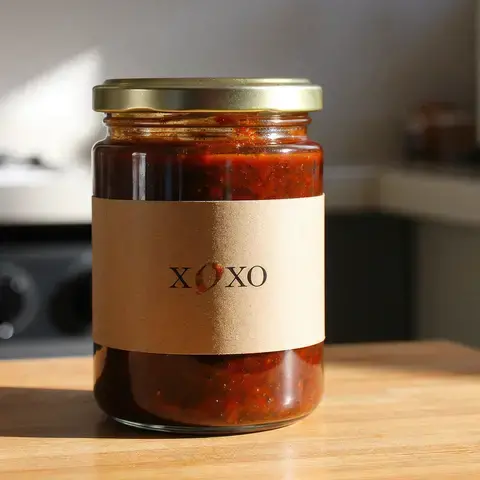Jamaar Julal's pastes and peasos
Julal’s projects (he is also the owner of JamBrü Ferments, which brews electrifying beverages like sorrel and lemongrass kombucha) exemplify the spectrum of influence helmed by figures like David Zilber and Jeremy Umansky (one of the authors of Koji Alchemy), who are open and willing to share their knowledge. Reflecting on writing the guide, Zilber, who has since moved on to a new role with Chr. Hansen, tells me: “It was always about the democratisation of fermentation, giving power to the people and making something that seemed a bit murky and mystical, practical and very possible to everyone who comes into contact with it.”
Noma’s Guide promotes a style of fermentation that forces one to look at not just what is locally available, but what is indigenous to a place. Julal’s black-eyed peaso is a prime example of how Noma’s dual legacies of democratisation of fermentation and seeking ingredients true to one’s geography are playing out.
As a classicist turned chef, I have long been perturbed by the disappearance of garum, the historical maligning of the ingredient by classical scholarship, and unsatisfactory answers as to why fish sauce in any form is no longer a main ingredient in Mediterranean cuisines. Classicists have long unfairly likened garum to modern day ketchup or Worcestershire sauce – neither of which is as ubiquitous nor valuable as garum was. The Dutch food historian Patrick Faas, writing in 1994, opens the garum section of his book Around the Roman Table with: “Garum was a highly salted fish sauce, comparable with and related to soy sauce, made from fermented fish. Rotten fish smells disgusting and in ancient Rome, garum factories stank. That ancient Romans used garum in nearly every dish gave later historians the impression that Roman cuisine must have been revolting.” Faas’ blunt description of garum does little to make anyone want to try it in their food, but he’s not wrong observing how garum has been disparaged.
Classics scholar Sally Grainger has more recently rectified garum’s ancient reputation, writing extensively about it, thoroughly tracing its appearance through classical texts, and teasing out the nuances of its associated terms: liquamen, allec, haimation and muria. Most significantly, and in a sense paving the way for modern garum, she concludes in an article entitled Garum and Liquamen, What’s in a Name? for the Journal of Maritime Archaeology: “One key point to stress is the need to be specific in how we use the terminology. Garum no longer serves as an all-purpose term.”
Nuances of garum aside, imagine my surprise when, five or six years ago, I noticed garum appear on modern day fine-dining menus after a hiatus of, well, 1500 years. I had previously only ever seen the term in texts like Apicius’ De Re Coquinaria and discussed by classical scholars. The resurrection of garum in modern parlance is in no small part due to Noma.
“Garum at Noma didn’t start as a direct avenue for food waste. They [under the direction of Lars Williams] were trying emulate Roman garums and use Danish ingredients,” Zilber tells me. After Thomas Frebel suggested making garum with meat, innovation took over, leading to the introduction of koji into the process of making protein-derived fermented sauce. The garum chapter in Noma’s Guide states: “If you add koji to the equation, you can reduce the time it takes to make garum by more than half.” Unlike early garum producers, the innovators at Noma did not spend long expecting salt and heat to be the driving factors of fermentation. The techniques developed at Noma brought forth sauces that are significant departures from classical garum. The term ‘garum’ is borrowed, then redefined and then, reinvented.
Jeremy Umansky now defines modern garum as “any flavourful sauce made using the same or similar processes to that used in ancient Rome. The ingredients may differ, but the process and end results are similar.” The Fermentation Association and the free-flow of information have sped up fermentation as a practice and “now you see garum made from everything from fungi to squirrel”. In terms of speed, the internet is to fermentation as koji is to garum.
The other ferments besides garum covered in Noma’s Guide have had long, uninterrupted histories. Shoyu, jiangyou and miso have all survived millennia, as have a wealth of fermented Asian fish sauces.
Classicist Dr. Ian Lockey brings climate change into the list of culprits that led to ancient garum’s demise in the Mediterranean, and points to Dr. Kyle Harper’s work. “From approximately the mid-second century BCE, to about 150-200 CE, the Roman climate was ideal for agricultural and forest growth, leading to an abundance of both economic opportunities and resources while also supporting a healthy population with almost no disease. After this period, a documented shift in climate allowed the spread of a series of plagues throughout large parts of the empire, particularly around the Mediterranean basin, that caused massive disruptions in trade and labour supply - sounds familiar - and led to conflict.”
“Obviously the collapse of the Roman imperial system in the west was a multi-faceted event, but climate change and resulting widespread disease (especially in an age without a clear understanding of germ theory) were two of the causes and often aren’t considered by historians who have traditionally focused on movements of people, political conflict, and the economy.”
Lockey’s thoughts lead me to ask Harper himself how this relates to garum. “I’m not an expert on what happens to garum, but my sense is that a lot of the industrial-scale capacity for garum production declines in the later empire, even before the empire really falls, as part of a more general transformation of the Roman economic system of production and exchange.” Harper steers me to Andrew Wilson’s research, which elucidates a severe reduction in the capacity of salt vats over time, everywhere they are discovered – capacity is at its peak 51-100 CE and at a low 351-400 CE.
On a microscopic and intimate level, I see very well how a sauce may go extinct. Early on during the Covid-19 pandemic, I closed my Philadelphia restaurant Poi Dog and morphed the brand into one that makes sauces for retail. Several months into this new venture, glass bottles and metal bottle caps became near impossible to source. Shipments of Japanese yuzu juice and dried bonito - essential ingredients in my lavender ponzu sauce - were delayed and stalled. There were hardly any delivery drivers at my Japanese importer to deliver them, even if they did appear. What if the supply chain that brought me these ingredients was permanently sundered? My lavender ponzu would face extinction.
Making garum in-house, as Julal will be doing at Honeysuckle, is a way of existing independently, outside of the industrial food supply chain. Umansky encourages this. “As far as garum and miso go, [with] chefs creating them in-house, they are able to make products that suit their exact specifications, needs, and wants. This is the desire of control that all serious chefs want… the flip side to this is that garums and misos can and do incorporate many food scraps that would be otherwise composted or trashed. Any time that a chef can serve as much food as comes in from their suppliers, that is an economic win.”
The possibilities were intended to be endless, as Zilber tells me: “On the book tour, I figured out this little alliteration: ‘the possibilities are far more important than the particularities'. And we structured the book in a way where we gave you five versions of everything in all these chapters, so to show you that there could be a sixth or a seventh or an eighth and so on.”
Laurent Hubert, vice president of food & beverage at Chr. Hansen cocks his head when I ask him about how the company combats food waste. “Is it really food waste, or is it about the protection or transformation of food to store it? If you think about cheese, it’s a fantastic way to store milk for a much longer period. There is no end of shelf life for cheese.” Rather than thinking of food waste as a problem to be solved, he sees food as having near endless potential.
What will our pandemic make extinct? Zilber says: “I think consumer tastes have changed during the pandemic, but also from a labour point of view, there were all these alarm bells, canaries in the coal mines of the restaurant industry. And the pandemic overnight just exacerbates all that.” There is still much that remains to be seen about what we will lose.
The legacy of Noma’s Guide can also be seen in the role Zilber now occupies with Chr. Hansen, as a liaison, or in his own words: “A plumber who sits between the bacteria produced by molecular biologists, and the salespeople who interface with where these products end up in the real world, whether it’s in Parmigiano Reggiano, Australian beer or even Southeast Asian fish sauce. A truly enormous amount of people is touched by Chr. Hansen’s microbes.”
Hubert chimes in: “We are working with David because he knows a lot about flavours, textures and the sensory impact of fermentation.” In working on cultures for Southeast Asian fish sauces, Zilber’s own dealings with garum have come a long way.
While ancient garum may be a relic of the past, a victim of circumstance, and - let us conjecture - its own pandemic circumstances, modern garum is a way forward, and just one way to address the circumstances of our own tenuous food cultures. The dearth of materials can set alight human creativity - which leads us to turkey gizzard garum injected into the Platonic ideal of a turkey hoagie - but the wealth of microbes continues to spur re-visitations of traditional methods, whether through the vastness of Chr. Hansen’s network, or books like Koji Alchemy and Noma’s Guide to Fermentation.














